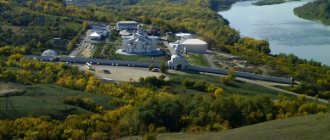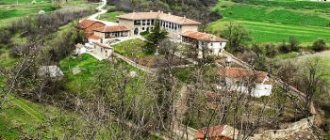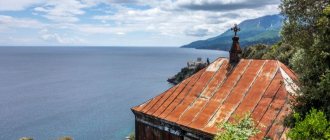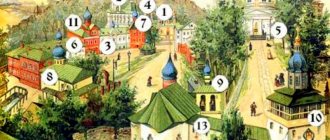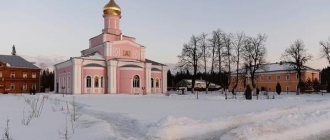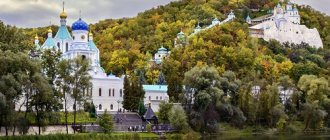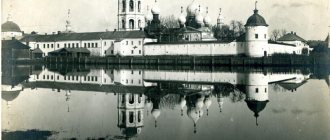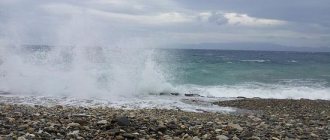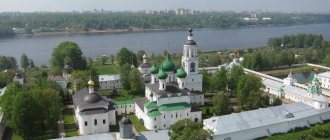The first Russian monastery - Assumption
The first surviving written mention of it as an active monastery dates back to February 1016 (under one of the acts stored in the Great Lavra, there is the signature of Gerasim “a monk by the grace of God, presbyter and abbot of the monastery of Rosov”).
Initially, the Rossov monastery, dedicated to the Dormition of the Blessed Virgin Mary, was located in a dense oak grove on the eastern slope of the Holy Mountain and was called “Theotokos” (another name is Xylurgu
, in Russian: Arborist, which is associated with the main occupation of the inhabitants of the monastery).
Nagorny Russik
Due to the increase in the number of inhabitants, the monastery was transferred to a new location - to a beautiful ravine surrounded by mountains, where the ancient Slavic monastery of the Thessalonian with the main temple in the name of the Holy Great Martyr Panteleimon, which had by that time fallen into decay and was in a dilapidated state, was located.
The Act of the Consecrated Cathedral of Holy Mount Athos (Prote John and other abbots), dated 1169, has been preserved, on the transfer forever to Abbot Xylurgus Lawrence and his monks of the monastery of the Holy Great Martyr Panteleimon and on confirmation of their ownership of Xylurgus. Since then, the monastery began to be called Nagorny Rusik.
During the XIII-XIV centuries, the St. Panteleimon Monastery (like other Athonite monasteries) was subjected to merciless plunder by the crusaders and sea pirates. This situation of the Russian monastery is further aggravated by the fact that the monastery’s ties with Russia are being disrupted, which for almost two and a half centuries fell under the Mongol-Tatar yoke (1243-1480). All these circumstances lead to the fact that the number of Russian monks is decreasing, the monastery is becoming poor, and is heading towards decline. From that time on, the monastery became predominantly Serbian in composition. Its ktitors (patrons) until 1489 were Serbian rulers from the Nemanjić, Hrebelyanović and Branković dynasties, who provided the monastery with large donations and contributions and thereby ensured its restoration.
Russik's importance on the Holy Mountain is growing. In the third Typikon (Charter) of the Holy Mountain, published in June 1406, the St. Panteleimon Monastery is listed fifth in the order of hierarchy among the Athonite monasteries. After the capture of Constantinople by the Turks in 1453 and the fall of the Byzantine Empire, Athos was included in the Ottoman Empire (Sultan Turkey).
Despite the confirmation by the Sultan's decrees of the rights and privileges of the St. Panteleimon Monastery and its monks, which they enjoyed in the Byzantine Empire, the Turkish authorities oppressed the monastery. They imposed heavy taxes on it, confiscated the monastery lands, forcing them to buy them back at high prices. Enormous damage was caused by the arbitrariness and extortions of Turkish officials. The situation was aggravated by raids by sea pirates and fires.
The establishment of the Ottoman yoke in Serbia (since 1489) put the St. Panteleimon Monastery in an extremely difficult situation. The main source of its existence are donations from the principalities of Wallachia and Moldavia (XV-XVI centuries), and from the end of the XV century. (after the liberation of Rus' from the Mongol-Tatar yoke) - Moscow Grand Dukes, Metropolitans, then Russian Tsars (from 1547) and Patriarchs (from 1589).
Moscow courtiers and clergy also made donations. In addition to monetary awards, monastic envoys received rich contributions (icons, church utensils and vestments, liturgical books). After 1497, the brethren of the monastery began to be replenished by monks arriving from Rus'.
Since 1507, the Grand Duke of Moscow Vasily III became the ktitor of the monastery. After the death of his father, the Russian Tsar John IV also patronized the monastery, who calls the St. Panteleimon Monastery his “first pilgrimage.” In 1561, the brethren of St. Panteleimon's Monastery numbered 170 people, incl. abbot, 15 priests, 7 deacons. There were 15 churches in the monastery, and the life was communal. There were 4 churches in the monastery of the Most Holy Theotokos (Xylurgu). Since 1584, the son of John IV, Tsar Theodore, began to provide generous assistance to the monastery.
In the 17th century after the Time of Troubles and with the accession of the Romanov dynasty, the abbots and elders of the St. Panteleimon Monastery repeatedly came to Moscow for donations. Letters of grant from Tsars Mikhail Fedorovich (reigned 1613-1645), Alexei Mikhailovich (reigned 1645-1676), John V and Peter I Alekseevich (ruled jointly 1682-1696) confirmed the benefits of monastic envoys and issued a royal salary for the correction of the monastery.
However, by the end of the 17th century, the monastery again experienced great difficulties and was practically left without material support from its patrons. The buildings gradually deteriorated, the number of brethren decreased. In 1705, by the decision of the Patriarch of Constantinople Gabriel III, the completely deserted St. Panteleimon Monastery was again restored as a Russian monastery and handed over to Russian monks led by Archimandrite Varlaam.
From the beginning of the 18th century, assistance to the monastery was provided by the first Russian Emperor Peter I, who, at the request of the abbots of the St. Panteleimon Monastery who repeatedly came to Moscow, gave generous donations, liturgical books, and church utensils from the royal treasury.
Since 1744, the Decree of the Holy Synod established an annual payment to the monastery. However, due to the complications of Russian-Turkish relations as a result of the wars that took place in the 18th century (1735-39, 1768-74, 1787-91), Russia’s ties with the monastery were constantly interrupted. The Ottoman authorities in every possible way prevented the monastery monks from traveling to Russia for assistance and the arrival of Russian monks to the monastery.
The difficult situation of the monastery continued until the middle of the 19th century. During this period, help came mainly from private individuals, the clergy, merchants, townspeople, serving nobility, Ukrainian Cossacks, most of all from the Smolensk province and Left Bank Ukraine. The current situation had a negative impact on the fate of the monastery. Many Russian monks were forced to leave the impoverished and crumbling monastery, which was declining and suffering from the exorbitant burdens of Turkish duties.
Not having sufficient funds to restore the dilapidated monastery and experiencing difficulties due to its remoteness from the sea, the monks decided to move to a new place around 1770 - to a small coastal cell that belonged to the monastery with a temple in honor of the Ascension of the Lord, located near the monastery arsana (boat pier) . The monastery remains on this site to this day.
Rules for self-registration of pilgrimage to the Holy Mountain
You can independently arrange 2 types of diamonitirion: general and monastic:
- The general one is ordered at the Pilgrimage Bureau in Thessaloniki for a 4-day stay on Mount Athos. Receipt takes place in the port city of Ouranoupoli, and, if necessary, is extended at the administrative center on the Holy Mountain (Kareya).
- An individual visa is issued by the target monastery for an unlimited period of stay according to the validity period of the Schengen visa.
The Russian Panteleimon Monastery on Mount Athos is a staircase between heaven and earth. Every year tens of thousands of pilgrims come to this Greek peninsula. Some of this huge number of people stay forever.
Author of the article: FLAGS
Article design: Svetlana Ovsyanikova
Coastal Russik
By the end of the 18th century, the coastal monastery of St. Panteleimon's Monastery was almost completely empty, and the abandoned Nagorny Russik finally fell into disrepair and remained in this state until 1868, when its revival began as a monastery of the coastal St. Panteleimon's Monastery. The situation of the Russian monastery was so difficult that the question was even raised about its exclusion from the number of Svyatogorsk monasteries and the sale of its land to other monasteries to pay off the debts owed to it.
However, in August 1803, a letter was issued from Patriarch Kallinikos V of Constantinople on the restoration of the hostel (cenovia) in the St. Panteleimon Monastery. For this purpose, an experienced elder in spiritual life is chosen to play the role of builder of the monastery - the 85-year-old Xenophonian hieromonk Savva, who comes to Istanbul for help and financial benefits. Until the end of 1806, Savva collected funds in Istanbul for the restoration of the monastery, but he did not receive benefits from the patriarchate due to the outbreak of the Russian-Turkish war of 1806-1812. Elder Savva's stay in Istanbul was marked by many miracles from the holy great martyr and healer Panteleimon. At the request of the seriously ill great dragoman of Porta, the Wallachian prince Scarlatus Callimachus, who vowed to become a ktitor of the St. Panteleimon Monastery if he recovered, Elder Savva served a prayer service at the bedside of the dying patient. Having recovered after this, the prince, who soon took the place of the ruler of Wallachia, fulfilled his promise. With his generous donations and funds collected by Sava, a cathedral in honor of St. Panteleimon, residential cells and other monastic buildings began to be built in 1812.
In 1814, the construction of the cathedral was completed, and in 1815 it was consecrated by the Patriarch of Constantinople. Gregory V (+ 1821).
In 1821, in Istanbul, on charges of secret relations with Russia, the ktitor of the monastery, Scarlatus Callimachus, was executed. On April 4, 1821, the builder Savva died at the age of 103. After the execution of Callimachus and the death of Sava, a time of crisis came for the monastery. Due to the difficult situation (unfinished construction, lack of food supplies), the monastery was forced to borrow money at high interest rates. Unable to pay them, he incurred new debts, mortgaged and sold property and lands.
Savva's successor as abbot of the monastery is a Bulgarian, Hieromonk Gerasim. However, in connection with the outbreak of the Greek national liberation revolution (1821-1829), Turkish troops were brought into the monastery, and the brethren were forced to leave the monastery, seizing the most valuable things and documents. The monks wandered for nine years, unable to return to the monastery, where Turkish troops ruled, plundered its property and destroyed the monastery premises. In 1830, the Greek inhabitants, on the advice of Elder Benedict, invited Russian monks to return to the monastery. Trying to get out of financial difficulties, the monastery during the years of Turkish rule was forced to go into debt, take out loans at extortionate interest rates, mortgage and lose its possessions. The monastery again fell into disrepair.
In October 1840, the Russian monk Ioannikiy (Solomentsev), the closest disciple of the confessor of all Russian Athonites, Hieroschemamonk Arseny, who lived in the desert cell of the Prophet Elijah near the Stavronikitsky Monastery, moved to the monastery with several brethren. Here he accepted the schema with the name Jerome, was ordained a hieromonk, and became the confessor of the brethren after the death of Hieroschemamonk Paul. Father Jerome is called the “spiritual renewer” of the St. Panteleimon Monastery. Under him, the spiritual and economic growth of the monastery took place. Being the confessor of the monastery brethren under abbots Gerasim and Macarius, he supervised all the work to restore the monastery. Under him, new churches were built (in 1846 - St. Mitrophan of Voronezh, in 1851 - the Intercession of the Blessed Virgin Mary, in 1867 - the Holy Blessed Prince Alexander Nevsky), a hospital building (in 1863), a fraternal Intercession building, a building in the eastern part monastery and paraklisa in them, premises for economic services and workshops, the refectory was expanded and painted, an iconostasis was installed in the Intercession Cathedral, the library building was restored. On his initiative, an icon painting school, a printing house, a lithographic and photographic workshop were founded. Over the years of the life of Father Jerome and the abbess of Father Macarius, about 60 churches, 19 cells, and 8 farmsteads that belonged to the monastery were built and restored.
By 1870, a building of fraternal cells with three paraklis (including the Church of St. Sava of Serbia) was built on Stary Russika. On June 3, 1871, the foundation of the cathedral church in the name of St. Great Martyr Panteleimon (on the site of an old church from the early 17th century, of which only the foundation remained by the mid-19th century). In 1870, the Kromitsa monastery was founded, and in 1882, the New Thebaida monastery. During the same period, dilapidated Greek cells were acquired, restored and inhabited: St. John Chrysostom, Trinity, St. Nicholas the Wonderworker (“Belozerka”), Georgievskaya, Kerassiyskaya, Apostle Andrew the First-Called, etc. In 1850, there were already about 200 monks in the monastery, from 30 of them were Russians.
In 1876, the Turks established that all Athonite monks were subjects of the Ottoman Empire. Nevertheless, the Russian inhabitants of the St. Panteleimon Monastery, paying an annual poll tax to the Turkish authorities, remained Russian, and not Turkish subjects. They were under the jurisdiction of the Russian Embassy in Turkey and under the patronage of the Russian Imperial House and the government in the person of the Russian Ambassador in Istanbul and the Consul in Thessaloniki.
The monastery received donations not only from the state, but also from private individuals. Among the benefactors of the monastery were Vyatka merchants G. Chernov and I. Stakheev, Moscow resident A. A. Smirnova, Vologda merchant E. Shuchev, St. Petersburg merchant S. M. Komarov, Tula merchants Sushkins, etc. Since the middle of the 19th century, the monastery’s connections with Russia are becoming regular. Athos and the monastery began to be visited and patronized by members of the Russian imperial house, the Grand Dukes: Konstantin Nikolaevich (in 1845), Alexei Alexandrovich (in 1867), Konstantin Konstantinovich (in 1881). Russian diplomats also visit Mount Athos: Russian ambassadors to Turkey (V.P. Titov, Count N.P. Ignatiev, A.I. Nelidov), Russian consuls in Thessaloniki, hierarchs of the Moscow Patriarchate, famous public and political figures, scientists, writers , artists. Due to the growing influx of monastics from Russia, the ratio between the Greek and Russian composition of monks is changing in favor of monks from Russia.
By the end of the 19th century. the monastery not only paid off the entire debt, but also began to provide assistance with church utensils, icons, money to Russian, Serbian, Greek, Bulgarian churches and monasteries, religious institutions, educational institutions, charitable organizations in Bulgaria, Istanbul, Russia, Russian spiritual missions in Jerusalem , Japan, Altai. Even the surrounding population of Macedonia received food aid from the monastery. On the initiative of Father Jerome, assistance with money and food was provided to all poor Athonite Syromach monks (about a thousand people). The elderly Russian monks who were in New Thebaid received a monthly allowance from the monastery with food, clothing and everything they needed.
On November 11, 1873, in Moscow, at the Epiphany Monastery on Nikolskaya Street, the Athos hieromonk Arseny (Minin) opened the Athos Chapel, built on the occasion of the arrival of shrines from the St. Panteleimon Monastery (closed and demolished in 1929).
By the end of the 19th century, there were more than a thousand monks in the monastery. Of these, there were more than eight hundred Russian monks. Among the remaining inhabitants, Greeks and South Slavs predominated. From the end of the 19th century, fearing the spread and strengthening of Russian influence on Mount Athos, the Patriarchate of Constantinople, the Turkish authorities, and after 1912 the Greek authorities, began to pursue a policy of limiting the influx of monks from Russia.
The monastery owned 60 churches (with monasteries, metokhi churches and farmsteads). The monastery had land holdings (metohi) outside Athos: the Kalamarian metokh near Thessaloniki (now within the city), the Sykian metokh on the Sikia peninsula (now Sithonia) and the Kassandrian metokh on the Kassandra peninsula. All the metohi were confiscated by the Greek government in 1924. By the beginning of the 20th century, the St. Panteleimon Monastery had metochions in Moscow, St. Petersburg, Odessa, Taganrog, Novosibirsk, Rostov-on-Don, Sukhumi, Istanbul, and Thessaloniki. The compound in Istanbul, taken away by the Turkish authorities at the beginning of the First World War, was returned completely plundered after the end of the war. The estate in Thessaloniki, damaged by fire in 1917, was sold in 1919 for a small sum. All farmsteads in Russia after the 1917 revolution were closed and declared state property.
| Panorama of the St. Panteleimon Monastery. Layout on a printed photograph. Around 1910 |
From the end of the 19th to the beginning of the 20th century, Russian monks distributed alms to the needy on a weekly basis.
The appearance of the Light-painted (photographic) image of the Virgin Mary on August 21, 1903 is associated with this custom (see). In 1910, the first separate two-story building on Mount Athos was built in the monastery for a library and an archaeological museum. Through the works of librarians Father Azaria (Poptsov) and especially Father Matthew (Olshansky), the library in the late 19th - early 20th centuries. turned into one of the largest book collections on Mount Athos, became a base for research, had a scientific reference apparatus at the advanced level of that time, and received books from major European antiquarians and publishers. In terms of the number of Greek manuscripts collected by Father Matthew, the library took fourth place among Athonite libraries (there were over 1,300 items, whereas in the middle of the 19th century there were only a few dozen). According to the number of Slavic and Russian manuscripts of the XIII-XIX centuries. the Russian monastery took third place (after Hilandar and Zograf).
Statistics
- con. XIX century - there are more than a thousand monks in the monastery (of which more than 800 are Russian; the rest were dominated by Greeks and South Slavs)
- 1910 - over 1,900 people were in the Panteleimon Monastery along with the New Thebaid
- September 1, 2004 - 62 inhabitants [1]
Photo[edit]
- Panteleimon Monastery*
- In the Panteleimon Monastery*
- In the Panteleimon Monastery*
- General view of the main entrance of the monastery*
- On the right in the temple is the icon of the holy great martyr and healer Panteleimon*
- Icon of the Holy Great Martyr and Healer Panteleimon*
- Panteleimon Monastery*
- Panteleimon Monastery
- Panteleimon Monastery
(*) Author of the photo: Prot. Konstantin Parkhomenko
Abbots
- Savva Svyatogorets (+ 1821) [2]
- Gerasim Svyatogorets (1830 [3] - May 10 (23), 1875)
- Makariy (Sushkin) (July 20, 1875 - June 19, 1889)
- Andrey (Verevkin) (1889 - October 30, 1903)
- Nifont (Chetverikov) (February 11, 1896 - November 3, 1903), governor
- Misail (Sapegin) (May 29 - November 13, 1905), governor
- Joachim (Kuznetsov) (May 31, 1909 - January 16, 1927), governor
- Ioaniky (Kutirev) (May 31, 1927 - December 12, 1937), governor
- Justin (Solomatin) (March 5, 1938 - April 1, 1940), governor
- Gabriel (Legach) (1965 - April 26, 1971), viceroy
- Jeremiah (Alekhine) (December 1978 - June 5, 1979), governor
Geographical and climatic features
Mount Athos occupies the extreme protrusion from the east of the Chalkidiki peninsula. The terrain changes from lowland to mountainous terrain with cliffs to the south and east, ending with a high pyramid 2033 m above sea level.
The climate is subtropical or Mediterranean. In winter the weather is mild, snow falls rarely and disappears after a short time. When visiting, it is worth considering the fact that from late autumn to early spring there is often heavy rain.
Water flowing from the mountains in the form of streams serves as an excellent source for drinking. Summers are very warm, temperatures in open areas can reach 55 °C. The best time to visit the mountain is from April to October.
| Month | Jan. | Feb. | March | Apr. | May | June | July | Aug. | Sep. | Oct. | Nov. | Dec. |
| t air | 16 | 16 | 17 | 20 | 24 | 28 | 29 | 29 | 27 | 24 | 21 | 17 |
| t water | 16 | 15 | 16 | 16 | 19 | 22 | 24 | 25 | 24 | 23 | 20 | 17 |
You can get to the monastery of the Holy Martyr Panteleimon by ferry from the Greek city of Ouranople. It is located right on the seashore. Old Rusik is located about 5 km from the main monastery, you can reach it on foot.
Leaving the monastery, you need to turn towards Xenophon, another coastal monastery, on the north side. Immediately, at the fork, take the road that goes to the right, deep into Mount Athos. After a short time, a mill appears on the way. The famous Orthodox saint, Reverend Silouan of Athos, carried out his obedience on it.
There are no more than 3-4 km left to Stary Rusik, but walking this path will be much more difficult than it seems at first glance, because the road goes uphill, winding along a forest path higher and higher. The monastery is located more than 400 m above sea level. It will take at least 1.5 hours to reach the monastery.
